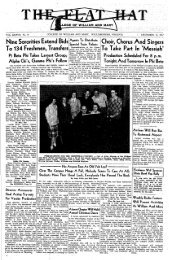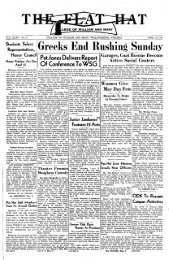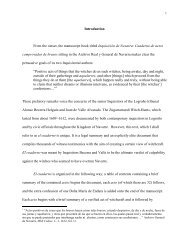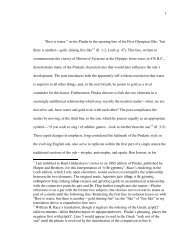Southern planter : devoted to agriculture, horticulture, and the ...
Southern planter : devoted to agriculture, horticulture, and the ...
Southern planter : devoted to agriculture, horticulture, and the ...
You also want an ePaper? Increase the reach of your titles
YUMPU automatically turns print PDFs into web optimized ePapers that Google loves.
: thing<br />
From <strong>the</strong> Farmer''s Practical Horse Farriery.<br />
The Horse <strong>and</strong> how <strong>to</strong> use Him.<br />
(concluded.)<br />
how <strong>to</strong> halter <strong>and</strong> lead a colt.<br />
As soon as you have gentled <strong>the</strong> colt a little,<br />
take <strong>the</strong> halter in your left h<strong>and</strong> <strong>and</strong> approach<br />
him as before, <strong>and</strong> on <strong>the</strong> same side that you<br />
have gentled him. If he is very timid about<br />
your approaching closely <strong>to</strong> him, you can get<br />
up <strong>to</strong> him quicker by making <strong>the</strong> whip a part<br />
of your arm, <strong>and</strong> reaching out very gently<br />
with <strong>the</strong> butt end of it ; rubbing him lightly<br />
on <strong>the</strong> neck, all <strong>the</strong> time getting a little closer,<br />
shortening <strong>the</strong> whip by taking it up in your<br />
h<strong>and</strong>, until you finally get close enough <strong>to</strong> put<br />
your h<strong>and</strong>s on him. If he is inclined <strong>to</strong> hold<br />
his head from you, put <strong>the</strong> iend of <strong>the</strong> halter<br />
strap round his neck, drop your whip, <strong>and</strong><br />
draw very gently ; he will let his neck give,<br />
<strong>and</strong> you can pull his head <strong>to</strong> you. Then<br />
take hold of that part of <strong>the</strong> halter which<br />
buckles over <strong>the</strong> <strong>to</strong>p of <strong>the</strong> head, <strong>and</strong> pass <strong>the</strong><br />
long side, or that part which goes in<strong>to</strong> <strong>the</strong><br />
buckle, under his neck, grasping it on <strong>the</strong> opposite<br />
side with your right h<strong>and</strong>, letting <strong>the</strong><br />
first strap loose—<strong>the</strong> latter will be sufficient <strong>to</strong><br />
hold his head <strong>to</strong> you. Lower <strong>the</strong> halter a little,<br />
just enough <strong>to</strong> get his nose in<strong>to</strong> that part<br />
which goes around it, <strong>the</strong>n raise it somewhat,<br />
<strong>and</strong> fasten <strong>the</strong> <strong>to</strong>p buckle, <strong>and</strong> you will have it<br />
all right. The first time you halter a colt, you<br />
should st<strong>and</strong> on <strong>the</strong> left side, pretty well back<br />
<strong>to</strong> his shoudler, only taking hold of that part of<br />
<strong>the</strong> halter which goes around his neck, <strong>the</strong>n<br />
with your two h<strong>and</strong>s about his neck, you can<br />
hold his head <strong>to</strong> you, <strong>and</strong> raise <strong>the</strong> halter on it<br />
without making him dodge by putting your<br />
h<strong>and</strong>s about his nose. You should have a long<br />
rope or strap ready, <strong>and</strong> as soon as you have<br />
<strong>the</strong> halter on, attach this <strong>to</strong> it, so that you can<br />
let him walk <strong>the</strong> length of <strong>the</strong> stable without<br />
letting go of <strong>the</strong> strap, or without making him<br />
pull on <strong>the</strong> halter, for if you only let him feel<br />
<strong>the</strong> weight of your h<strong>and</strong> on <strong>the</strong> halter, <strong>and</strong> give<br />
him rope when he runs from you, he will<br />
never rear, pull, or throw himself, yet you will<br />
be holding him all <strong>the</strong> time, <strong>and</strong> doing more<br />
<strong>to</strong>wards gentling him than if you had <strong>the</strong> power<br />
<strong>to</strong> snub him right up, <strong>and</strong> hold him <strong>to</strong> one<br />
spot ; because he does not know anything<br />
about his strength, <strong>and</strong> if you don't do any<br />
<strong>to</strong> make him pull, he will never know<br />
that he can. In a few minutes you can begin<br />
<strong>to</strong> control him with <strong>the</strong> halter, <strong>the</strong>n shorten<br />
<strong>the</strong> distance between yourself <strong>and</strong> <strong>the</strong> horse,<br />
by taking up <strong>the</strong> strap in your h<strong>and</strong>.<br />
As soon as he will allow you <strong>to</strong> hold him by<br />
a <strong>to</strong>lerable short strap, <strong>and</strong> step up <strong>to</strong> him<br />
without flying back, you can begin <strong>to</strong> give him<br />
some idea about leading. But <strong>to</strong> do this, do<br />
not go before <strong>and</strong> attempt <strong>to</strong> pull him after<br />
you, but commence by pulling him very quietly<br />
<strong>to</strong> one side. He has nothing <strong>to</strong> brace ei<strong>the</strong>r<br />
side of his neck, <strong>and</strong> will soon yield <strong>to</strong> a steady,<br />
26<br />
THE SOUTHERN PLANTER. 401<br />
gradual pull of <strong>the</strong> halter ;<br />
<strong>and</strong> as soon as you<br />
have pulled him a step or two <strong>to</strong> one side, step<br />
up <strong>to</strong> him <strong>and</strong> caress him, <strong>and</strong> <strong>the</strong>n pull him<br />
again, repeating this operation until you can<br />
pull him around in every direction, <strong>and</strong> walk<br />
about <strong>the</strong> stable with him, which you can do in<br />
a few minutes, for he will soon think when<br />
you have made him step <strong>to</strong> <strong>the</strong> right or left a<br />
few times, that he is compelled <strong>to</strong> follow <strong>the</strong><br />
pull of <strong>the</strong> halter, not knowing that he has <strong>the</strong><br />
power <strong>to</strong> resist your pulling; besides, you have<br />
h<strong>and</strong>led him so gently that he is not afraid of<br />
you, <strong>and</strong> you always caress him when he<br />
comes up <strong>to</strong> you, <strong>and</strong> he likes that, <strong>and</strong> would<br />
just as leave follow you as not. And after he<br />
has had a few lessons of that kind, if you turn<br />
him out in a lot he will come up <strong>to</strong> you every<br />
opportunity he gets. You should lead him<br />
about in <strong>the</strong> stable some time before you take<br />
him out, opening <strong>the</strong> door, so that he can see<br />
out, leading him up <strong>to</strong> it <strong>and</strong> back again, <strong>and</strong><br />
past it. See that <strong>the</strong>re is nothing on <strong>the</strong> outside<br />
<strong>to</strong> make him jump when you take him out,<br />
<strong>and</strong> as you go out with him, try <strong>to</strong> make him<br />
go very slowly, catching hold of <strong>the</strong> halter close<br />
<strong>to</strong> <strong>the</strong> jaw with your left h<strong>and</strong>, while <strong>the</strong> right<br />
is resting on <strong>the</strong> <strong>to</strong>p of his neck, holding <strong>to</strong> his<br />
mane. After you are out with him a little<br />
while, you can lead him about as you please.<br />
Don't let any second person come up <strong>to</strong> you<br />
when you first take him out ; a stranger taking<br />
hold of <strong>the</strong> halter would frighten him, <strong>and</strong><br />
make him run. There should not be even any<br />
one st<strong>and</strong>ing near him. If you are alone, <strong>and</strong><br />
manage him right, it will not require any more<br />
force <strong>to</strong> lead or hold him than it would <strong>to</strong><br />
manage a broke horse.<br />
HOW TO LEAD A COLT BY THE SIDE OF A BROKE<br />
HORSE.<br />
If you should want <strong>to</strong> lead your colt by <strong>the</strong><br />
side of ano<strong>the</strong>r horse, as is often <strong>the</strong> case, I<br />
would advise you <strong>to</strong> take your horse in<strong>to</strong> <strong>the</strong><br />
stable, attach a second strap <strong>to</strong> <strong>the</strong> colt's halter,<br />
<strong>and</strong> lead up your horse along side of him.<br />
Then get on <strong>the</strong> broke horse <strong>and</strong> take one<br />
strap around his breast, under his martingale,<br />
(if he has one on,) holding it in your left h<strong>and</strong>.<br />
This will prevent <strong>the</strong> colt from getting back<br />
<strong>to</strong>o far; besides, you will have more power <strong>to</strong><br />
hold him, with <strong>the</strong> strap pulling against <strong>the</strong><br />
horse's breast. The o<strong>the</strong>r strap take up in<br />
your right h<strong>and</strong>, <strong>to</strong> prevent him from running<br />
ahead : <strong>the</strong>n turn him about a few times in <strong>the</strong>stable,<br />
<strong>and</strong> if <strong>the</strong> door is wide enough, ride out<br />
with him in that position; if not, take <strong>the</strong>broke<br />
horse out first, <strong>and</strong> st<strong>and</strong> his breast up<br />
against <strong>the</strong> door, <strong>the</strong>n lead <strong>the</strong> colt <strong>to</strong> <strong>the</strong> same<br />
spot, <strong>and</strong> take <strong>the</strong> straps as before directed, one<br />
on each side of his neck, <strong>the</strong>n let some one<br />
start <strong>the</strong> colt out, <strong>and</strong> as he comes out, turn<br />
your horse <strong>to</strong> <strong>the</strong> l^ft, <strong>and</strong> you muII have <strong>the</strong>m<br />
all right. This is <strong>the</strong> best way <strong>to</strong> lead a colt;<br />
you can manage any kind of a colt in this way<br />
without any trouble, for if he tides- <strong>to</strong> run
















